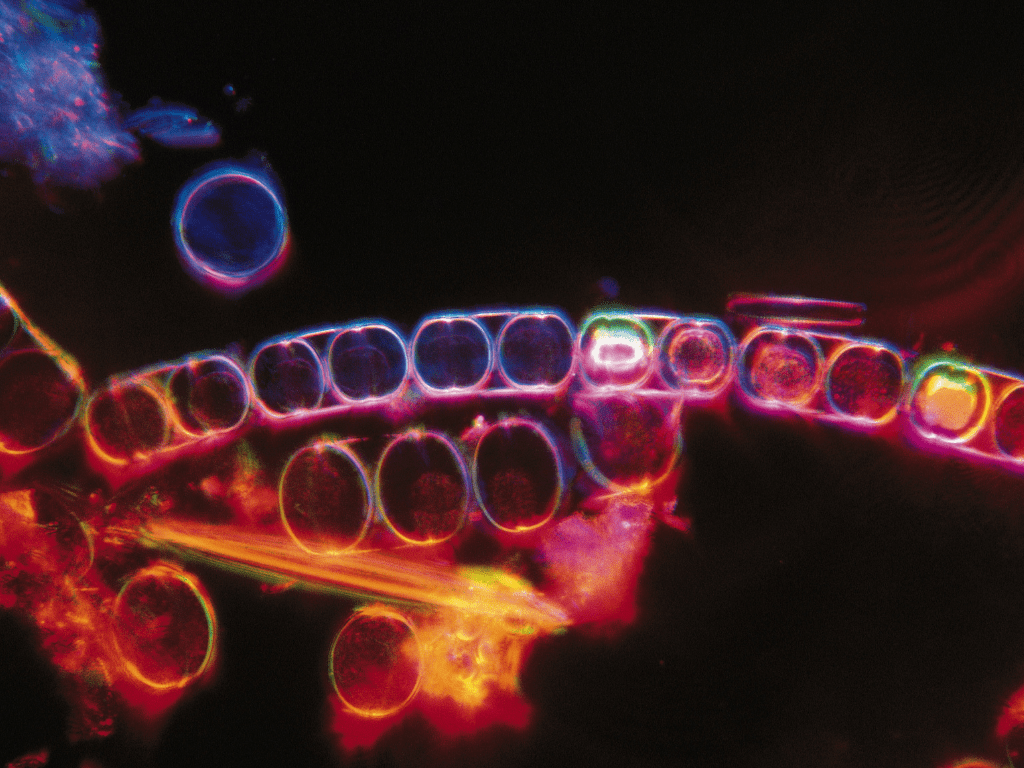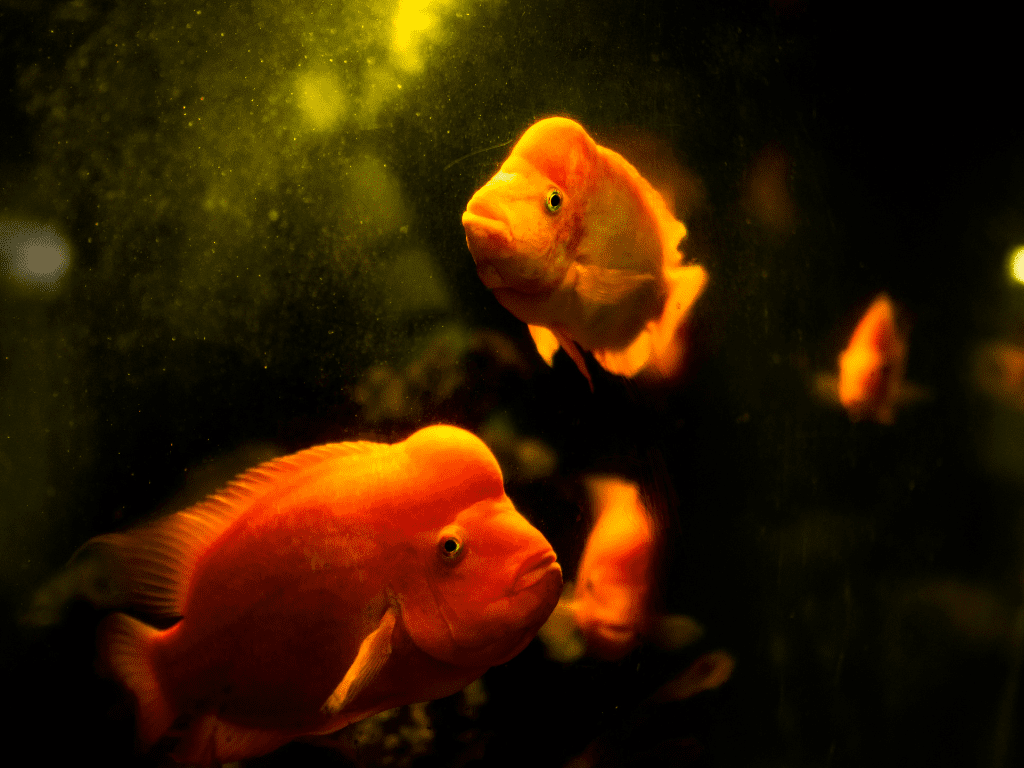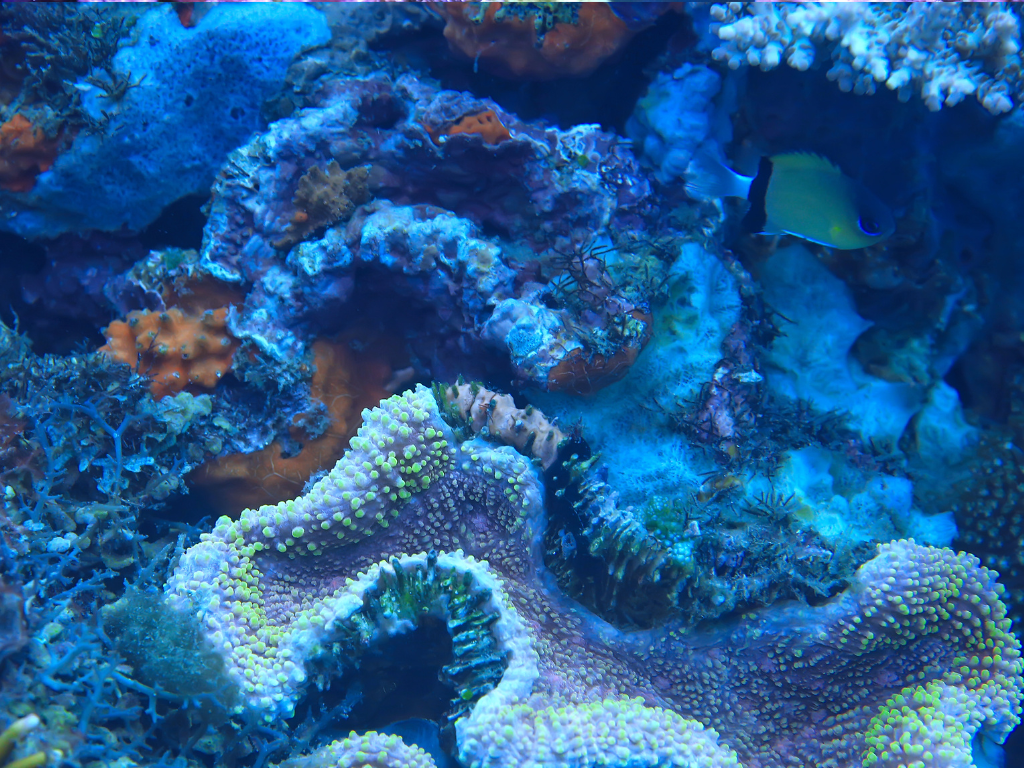Diatomeele sunt o apariție frecventă în acvariile marine, în special în cazul instalațiilor noi. Dacă aveți de-a face cu un acvariu marin cu diatomee, nu sunteți singur. Aceste microalge maronii pot acoperi rapid sticla, substratul și chiar coralii, făcând ca acvariul dvs. să pară tulbure și murdar. Deși diatomeele sunt în general inofensive, ele pot fi inestetice și necesită gestionare pentru a vă menține acvariul marin sănătos și atractiv din punct de vedere vizual.
În acest articol, vom analiza cauzele formării diatomeelor, modul de gestionare a acestora și măsurile pe care le puteți lua pentru a le împiedica să pună stăpânire pe acvariul dvs. marin cu diatomee. De asemenea, vom menționa soluții eficiente precum AQUAQUICK, un detergent sigur și ecologic pentru menținerea igienei acvariului dvs.
Ce sunt diatomeele?
Diatomeele sunt un tip de alge care se dezvoltă atât în apă dulce, cât și în apă sărată. Acestea au pereți celulari pe bază de siliciu care le fac să pară sticloase. Într-un acvariu marin cu diatomee, acestea apar de obicei ca o peliculă maro sau gălbuie care acoperă suprafețele acvariului, inclusiv sticla, rocile și chiar coralii vii.
De ce apar diatomeele într-un acvariu marin
Diatomeele sunt adesea primele alge care apar în acvariile noi din cauza mai multor factori:
- Niveluri ridicate de silicat: Diatomeele se hrănesc cu silicați, care se găsesc frecvent în apa de la robinet și în amestecurile de sare de calitate scăzută. Într-un acvariu marin cu diatomee, nivelurile ridicate de silicați le pot încuraja creșterea.
- Dezechilibrul nutrienților: Excesul de substanțe nutritive precum fosfații și nitrații furnizează diatomeelor combustibilul de care au nevoie pentru a se dezvolta. Hrănirea necorespunzătoare și lipsa schimbărilor de apă pot contribui la această problemă.
- Condiții de iluminare: Un iluminat slab optimizat poate stimula creșterea diatomelor. Rezervoarele expuse la prea multă lumină văd adesea înfloriri de diatomee mai frecvente.
Diatomeele sunt dăunătoare?
Deși diatomeele în sine nu sunt direct dăunătoare vieții marine, ele pot cauza probleme dacă nu sunt gestionate. Într-un acvariu marin cu diatomee, creșterea lor excesivă poate duce la epuizarea oxigenului, în special noaptea, când ele respiră. De asemenea, diatomeele pot concura cu algele benefice pentru nutrienți, afectând echilibrul general al acvariului.
Modalități eficiente de a controla diatomeele într-un acvariu marin

Controlul diatomeelor într-un acvariu marin cu diatomee necesită o combinație de igienă bună a acvariului, gestionare adecvată a nutrienților și metode de curățare corecte. Iată câteva strategii eficiente pentru a reduce și a gestiona diatomeele din acvariu.
Întreținerea regulată și schimbarea apei în bazinul marin cu diatomee
Unul dintre cele mai importante lucruri pe care le puteți face pentru acvariul dvs. marin cu diatomee este să vă ocupați de întreținerea regulată:
- Schimbări frecvente ale apei: Efectuarea de schimbări regulate ale apei ajută la eliminarea excesului de nutrienți și silicați din apă. Utilizarea apei RO (cu osmoză inversă) în loc de apă de la robinet este deosebit de importantă, deoarece reduce cantitatea de silicați care intră în acvariu.
- Curățarea substratului: Diatomeele se dezvoltă adesea pe substratul acvariului. Aspirarea regulată a substratului în timpul schimburilor de apă poate ajuta la îndepărtarea diatomeelor înainte ca acestea să preia controlul.
- Curățarea sticlei: Sticla acvariului dvs. marin cu diatomee se poate acoperi rapid cu o peliculă de diatomee. Utilizați un răzuitor sau un burete pentru a-l menține curat. Utilizarea produselor ecologice, cum ar fi AQUAQUICK, vă asigură că acvariul dvs. rămâne curat fără a vă afecta viața marină.
Reducerea silicaților din apă
Deoarece diatomeele se hrănesc cu silicați, gestionarea acestor niveluri este esențială pentru controlul prezenței lor. Iată câteva modalități de a reduce silicații din acvariul dvs. marin cu diatomee:
- Treceți la apă RO: Apa de la robinet este o sursă comună de silicați. Trecerea la apă RO poate reduce semnificativ nivelul de silicați și poate minimiza proliferarea diatomelor.
- Utilizați absorbanți de silicat: Mulți acvaristi adaugă produse de eliminare a silicaților la sistemul de filtrare al acvariului lor pentru a reduce creșterea diatomelor. Aceste produse ajută la absorbția silicaților din apă, înfometând diatomeele.
- Amestec de sare de înaltă calitate: Amestecurile de sare de calitate scăzută pot introduce silicați în acvariu. Optați pentru sare marină de înaltă calitate, fără silicați, pentru a minimiza riscul de apariție a diatomeelor în diatomee rezervor marin.
Gestionarea nutrienților
Controlul nutrienților este esențial pentru menținerea unui acvariu marin echilibrat pentru diatomee. Diatomeele se hrănesc cu nitrați și fosfați, astfel încât gestionarea acestor nutrienți le va limita creșterea.
- Testați apa în mod regulat: Testați periodic nivelul de fosfați și nitrați din apa din acvariu. Mențineți aceste niveluri cât mai scăzute posibil pentru a reduce creșterea diatomelor.
- Hrănirea corectă: Supraalimentarea contribuie la un exces de nutrienți în acvariu. Hrăniți-vă peștii doar cu ceea ce pot consuma în câteva minute și îndepărtați orice hrană neconsumată.
- Îmbunătățiri de filtrare: Luați în considerare modernizarea sistemului de filtrare al acvariului dvs. pentru a îmbunătăți exportul de nutrienți. Scrematoarele de proteine, reactoarele de fosfați și refugiile pot ajuta la reducerea nivelului de nutrienți din acvariul dvs. marin cu diatomee.
Ajustări ale iluminatului pentru a reduce creșterea diatomelor
Diatomeele se dezvoltă în condiții de iluminare specifice, astfel încât ajustarea iluminării acvariului poate face o mare diferență în controlul creșterii lor.
Iluminare optimă pentru controlul diatomelor
- Reducerea intensității iluminatului: Dacă iluminarea acvariului dvs. este prea puternică sau rămâne aprinsă pentru perioade lungi de timp, aceasta poate favoriza creșterea diatomelor. Reducerea intensității sau scurtarea ciclului de iluminare poate ajuta la controlul diatomeelor în acvariul dvs. marin cu diatomee.
- Reglați Spectrul de lumină: Diatomeele sunt deosebit de sensibile la lumina albastră. Reglarea iluminării acvariului dvs. pentru a favoriza spectrul roșu sau galben poate descuraja creșterea diatomelor.
- Limitați lumina naturală a soarelui: Dacă acvariul dvs. este expus la lumina directă a soarelui, diatomeele pot înflori. Luați în considerare mutarea acvariului departe de ferestre sau utilizarea de umbrele pentru a reduce expunerea la lumina soarelui.
Controlul biologic al diatomelor

Într-un acvariu marin cu diatomee, metodele de control biologic pot fi foarte eficiente în reducerea diatomeelor. Anumite specii marine sunt consumatoare naturale de diatomee, iar adăugarea lor în acvariu vă poate ajuta să țineți diatomeele sub control.
Specii consumatoare de diatomee
- Melci: Se știe că specii precum melcii turbo și melcii nerite consumă diatomee și ajută la menținerea curățeniei suprafețelor acvariului.
- Crabi: Crabii smarald și anumiți crabi pustnici sunt, de asemenea, excelenți în hrănirea cu diatomee într-un acvariu marin cu diatomee.
- Pește: Se știe, de asemenea, că unele specii de pești, cum ar fi tangii și anumite blenii, se hrănesc cu diatomee.
AQUAQUICK: O soluție sigură pentru curățarea diatomelor
Deși există multe produse disponibile pentru curățarea rezervoarelor, este esențial să folosiți ceva sigur pentru mediul marin. AQUAQUICK este o soluție de curățare foarte eficientă, biodegradabilă, care poate fi utilizată pentru a curăța suprafețele și echipamentele din acvariul dvs. marin cu diatomee. Spre deosebire de detergenții chimici agresivi, AQUAQUICK este ecologic și sigur pentru toate viețuitoarele marine, ceea ce îl face o alegere excelentă pentru întreținerea regulată.
Încorporarea AQUAQUICK în rutina dvs. de curățare asigură că diatomeele și alte alge sunt ținute sub control fără a risca sănătatea peștilor sau a coralilor. Pur și simplu folosiți-l pentru a curăța sticla acvariului, substratul și echipamentul pentru un mediu impecabil, fără diatomee.
Prevenirea pe termen lung a diatomeelor
Odată ce ați reușit să controlați diatomeele din acvariul dvs. marin cu diatomee, este important să luați măsuri pentru a preveni apariția viitoarelor focare. Iată câteva strategii pe termen lung pentru a vă menține acvariul fără diatomee:
- Testare periodică: Monitorizați parametrii cheie ai apei, cum ar fi nivelurile de silicat, fosfat și nitrat, pentru a detecta din timp orice dezechilibru.
- Întreținere consecventă: Schimburile regulate de apă, curățarea substratului și curățarea sticlei sunt esențiale pentru menținerea unui mediu sănătos în acvariu.
- Controlul iluminatului: Reglați iluminatul acvariului dvs. pentru a preveni apariția unor condiții favorabile diatomelor.
- Utilizarea de detergenți precum AQUAQUICK: Încorporarea unei soluții de curățare sigure, precum AQUAQUICK, în rutina dumneavoastră vă va ajuta să mențineți un mediu fără diatomee.

Concluzie
Confruntarea cu un acvariu marin cu diatomee poate fi frustrantă, dar cu îngrijire adecvată, întreținere și strategii corecte, puteți controla și preveni în mod eficient creșterea acestora. Întreținerea periodică a rezervorului, gestionarea nutrienților și metodele de control biologic joacă toate un rol esențial în reducerea diatomeelor. În plus, utilizarea produselor de curățare ecologice precum AQUAQUICK poate face o diferență semnificativă în menținerea unui acvariu marin curat și sănătos.
Înțelegând cauzele și soluțiile pentru diatomee în acvariul dvs. marin cu diatomee, vă puteți păstra acvariul frumos și puteți asigura un mediu sănătos pentru viața dvs. marină.














